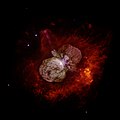Ficheiro:Eta Carinae.jpg
Aspeto

Dimensões desta antevisão: 600 × 599 píxeis. Outras resoluções: 240 × 240 píxeis | 480 × 480 píxeis | 769 × 768 píxeis | 1 025 × 1 024 píxeis | 2 015 × 2 013 píxeis.
Ficheiro original (2 015 × 2 013 píxeis, tamanho: 163 kB, tipo MIME: image/jpeg)
Histórico do ficheiro
Clique uma data e hora para ver o ficheiro tal como ele se encontrava nessa altura.
| Data e hora | Miniatura | Dimensões | Utilizador | Comentário | |
|---|---|---|---|---|---|
| atual | 09h41min de 18 de dezembro de 2017 |  | 2 015 × 2 013 (163 kB) | The NMI User | Reverted to version as of 14:14, 1 May 2008 (UTC) |
| 14h45min de 13 de março de 2017 |  | 3 000 × 2 998 (1,18 MB) | Leogorgon | larger file size | |
| 14h14min de 1 de maio de 2008 |  | 2 015 × 2 013 (163 kB) | Vol de nuit | {{Information |Description=(NASA News Release) A huge, billowing pair of gas and dust clouds are captured in this stunning NASA Hubble Space Telescope image of the supermassive star Eta Carinae. Using a combination of image processing techniques (ditheri |
Utilização local do ficheiro
Não há nenhuma página que use este ficheiro.
Utilização global do ficheiro
As seguintes wikis usam este ficheiro:
- Uso no domínio da.wikipedia.org
- Uso no domínio en.wikipedia.org
- Star
- Eta Carinae
- Wikipedia:Selected anniversaries/March 11
- Wikipedia:Today's featured article/March 2017
- Wikipedia:WikiProject Wikipack Africa Content/Wikipedia:Showcase
- Wikipedia:WikiProject WikiFundi Content/Eta Carinae
- Wikipedia:Today's featured article/requests/Eta Carinae
- Wikipedia:Today's featured article/March 12, 2017
- Wikipedia:Main Page history/2017 March 12
- Wikipedia:WikiProject WikiFundi Content/Wikipedia:Showcase
- Wikipedia:Main Page history/2022 March 11
- Wikipedia:Main Page history/2022 March 11b
- Wikipedia:Main Page history/2023 March 11
- Wikipedia:Main Page history/2023 March 11b
- User:2003 LN6/sandbox/Eta Carinae variable
- List of luminous blue variable stars
- Uso no domínio en.wikiversity.org
- User:Marshallsumter/Radiation astronomy2/Visuals
- User:Marshallsumter/Radiation astronomy2/Violets
- Stars/Astronomy
- User:Marshallsumter/Radiation astronomy2/Violets/Quiz
- Stars/Sun/Astronomy/Quiz
- User:Marshallsumter/Radiation astronomy/Courses/Principles/Hourly 2
- User:Marshallsumter/Radiation astronomy/Courses/Principles/Final quiz
- Draft:Original research/Io/Quiz
- Titan/Quiz
- Stars/Solar systems/Quiz
- Moon/Quiz
- Earth/Quiz
- User:Marshallsumter/Radiation astronomy/Colors/Quiz
- Volcanoes/Io/Quiz
- Stars/Violets
- User:Marshallsumter/Radiation astronomy2/Stars
- Stars/Violets/Quiz
- Uso no domínio es.wikipedia.org
- Uso no domínio fr.wikipedia.org
- Uso no domínio hi.wikipedia.org
- Uso no domínio it.wikibooks.org
- Uso no domínio la.wikipedia.org
- Uso no domínio mk.wikipedia.org
- Uso no domínio ms.wikipedia.org
- Uso no domínio my.wikipedia.org
- Uso no domínio oc.wikipedia.org
- Uso no domínio ru.wikipedia.org
- Uso no domínio sk.wikipedia.org
- Uso no domínio sr.wikipedia.org
- Uso no domínio th.wikipedia.org
Ver mais utilizações globais deste ficheiro.

